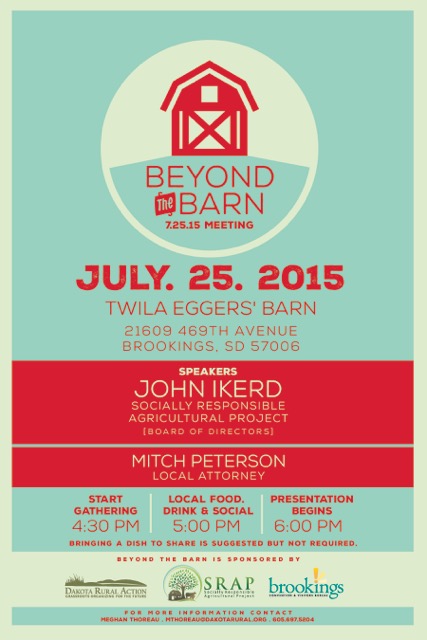CAFOs and biochar headline two educational social events near Brookings this weekend.
 First up, Dakota Rural Action is hosting “Beyond the Barn,” a combination potluck and lecture program featuring two speakers on confined animal feeding operations—i.e., the giant feedlots that imperil our water, air, and property values. John Ikerd, professor emeritus of ag economics at University of Missouri–Columbia, will discuss his research on and experience with the harms CAFOs do to rural communities. (For a preview, check out Professor Ikerd’s 2007 manifesto on factory farms.) Then local lawyer Mitch Peterson will talk about laws surrounding CAFOs and the ways citizens may challenge CAFO permits and operations. “Beyond the Barn takes place at Twila Eggers’s barn, 21609 469 Ave., southwest of Brookings.
First up, Dakota Rural Action is hosting “Beyond the Barn,” a combination potluck and lecture program featuring two speakers on confined animal feeding operations—i.e., the giant feedlots that imperil our water, air, and property values. John Ikerd, professor emeritus of ag economics at University of Missouri–Columbia, will discuss his research on and experience with the harms CAFOs do to rural communities. (For a preview, check out Professor Ikerd’s 2007 manifesto on factory farms.) Then local lawyer Mitch Peterson will talk about laws surrounding CAFOs and the ways citizens may challenge CAFO permits and operations. “Beyond the Barn takes place at Twila Eggers’s barn, 21609 469 Ave., southwest of Brookings.
If you aren’t too stuffed with potato salad and CAFO knowledge, you can head up Medary to Bill and Julie Ross’s Good Roots Farm and Gardens, 40 acres of unfactory-like farm north of Brookings at 3712 Medary Ave., at 8 p.m. to see your public university research dollars at work and learn about how biochar can boost your garden soil quality:
The free event includes a fireside explanation of how to make biochar, including indicators of its quality, and how to apply it. Free biochar (mixed with compost) will be given away to those who bring containers (suggested size: gallon ice cream bucket.)
Biochar is a special kind of charcoal; it’s ideal for enhancing the soil ecosystem. Biochar provides a perfect physical matrix for soil microbiota to thrive – it’s like a party house for the soil! Dr. Trish Jackson of SDSU has led the South Dakota Board of Regent’s funded research project, “Farming with Biochar: Quantifying Gains in Natural and Financial Capital”….
…At the biochar party, Dr. Jackson and her team will demonstrate how to make biochar in a burn pit using wood from the farm. This process requires no prior know-how and no special equipment. It’s a simple, straightforward method developed by Pacific Biochar’s Josiah Hunt, to make large or small quantities of biochar in a just a few hours. The biochar can then be mixed with soil for the garden, for potting mix; it can be directly applied as a top dressing to established plants or placed in a manure spreader for larger scale applications [press release, South Dakota State University, 2015.07.13].
Keep CAFOs from fouling your soil, then make you dirt better with biochar—how much more education could you ask for on a summer Saturday?
Rock on Dakota Rural Action and Bill and Julie!
Biochar was new to me, so I did a little looking. It seems the technique that creates biochar has been used for millenia. There are advocates who say it can play a role in reducing carbon. Excellent! An enhancer for the soil and a counter global warming tool. Woo-hoo!
There is ano international biochar organization here: http://www.biochar-international.org/biochar
Wikipedia has a nice article too.
Used to burn corn cobs and dry wood in cattle tank heater in the winter and after a couple months,clean ashes out and scatter them on snow in garden. Ash is supposed to be good for the soil. This stuff felt grainy like sand. Some farmers used to shell ear corn and return the cobs to the field to lighten up wetter soils. All corn stalks used for cattle bedding was hauled back onto the fields the following fall before new bedding was cut.